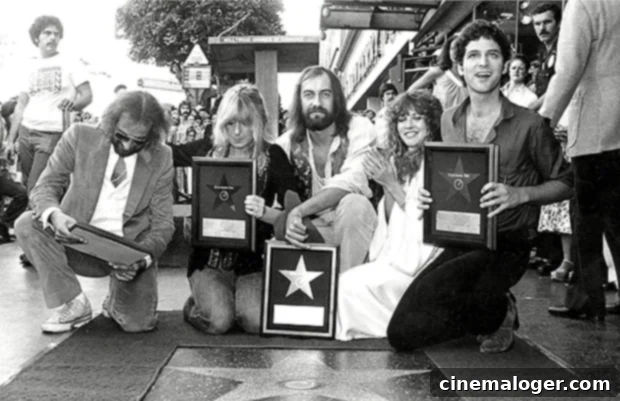Stevie Nicks and Lindsey Buckingham: The Enduring Saga of Fleetwood Mac’s Most Iconic and Tumultuous Love Story
In the annals of classic rock history, few relationships burn as brightly and leave as profound a mark as that of Stevie Nicks and Lindsey Buckingham. Like figures on a timeless Tarot card, their destinies appear perpetually, fatefully intertwined – a dramatic dance of passion, creativity, and profound heartbreak. This iconic duo, celebrated for their pivotal roles in Fleetwood Mac and their individual solo careers, masterfully channeled their fiery connection and eventual animosity into some of the most enduring music of our time. For anyone curious about the intense personal stories behind beloved songs like “Go Your Own Way,” “Dreams,” and countless others, this deep dive explores the tantalizing and tumultuous journey of Stevie and Lindsey.
The Genesis of a Musical Pair: Early Life and Buckingham Nicks
Stevie Nicks and Lindsey Buckingham’s paths first converged in the vibrant cultural landscape of Palo Alto, California, during the 1960s. Both attended Menlo-Atherton High School, and their shared passion for music quickly drew them into the same social circles. At the time, Buckingham was honing his craft in a local psychedelic rock band called Fritz. When two of the group’s members departed for college, Buckingham, recognizing Nicks’ undeniable talent, invited her to join as the lead singer, a pivotal moment detailed by the Los Angeles Times.
Initially, their connection was purely professional, their romantic lives separate as they dated other people while performing with Fritz. However, this dynamic was poised for a significant shift. By the early 1970s, Fritz’s prospects began to wane, prompting Buckingham and Nicks to make a bold move to Los Angeles in pursuit of their musical dreams. This geographical and professional leap inadvertently propelled their personal relationship forward. Stevie later reflected on this turning point, stating in Stephen Davis’s biography, “Gold Dust Woman,” that she wasn’t sure they would have become a couple had they not left the band, acknowledging that the circumstance “kind of pushed us together.” A minor setback occurred when Buckingham contracted mononucleosis, delaying their L.A. relocation by a year.

In a television interview cited by Far Out Magazine, Nicks fondly recalled those nascent years: “I loved him before he was a millionaire. We were two kids out of Menlo-Atherton High School. I loved him for all the right reasons. We did have a great relationship at first. I loved taking care of him and the house.” Her words paint a picture of genuine affection and domestic bliss before the pressures of fame took hold.
The duo finally established themselves in Los Angeles in 1972. Operating under the name Buckingham Nicks, they released their self-titled album in 1973. While this folk-rock effort has garnered retrospective critical acclaim in the decades following its debut, as noted by Pitchfork, it tragically flopped upon its initial release, leading to their record label dropping them. This period saw Buckingham working as a session guitarist for the legendary Don Everly, while Nicks took on the demanding role of a waitress to make ends meet.
Nicks’ resilience and pragmatic approach to their early struggles are evident in her reflections. She told Mass Live, “I loved being a waitress… I did lunches. I made good money. I came home with good money. It was enough to pay our rent, and it was enough to pay our food, and it was enough to pay for our Toyota that had no reverse… It was fun, and I made really great money, and I had no problem being the breadwinner because really, what was Lindsey Buckingham going to do? Be a waiter? I don’t think so. He tried telemarketing for one day, and the first person who hung up on him that was it, he quit. We came through it with a great laugh.” This anecdote highlights her grounded nature and their shared struggle before the whirlwind of global fame.
Joining Fleetwood Mac: A Crossroads for Love and Career
The fateful call from Fleetwood Mac arrived at a precarious moment for Stevie and Lindsey. “We were breaking up when Fleetwood Mac asked us to join,” Nicks candidly revealed to Billboard in 2014. The existing members of the band—Mick Fleetwood, John McVie (who, along with Mick, formed the “Mac” in the band’s name), and John’s wife, Christine McVie—encountered Buckingham at a recording studio. Mick Fleetwood was so profoundly impressed by Lindsey’s distinctive guitar prowess that he promptly extended an invitation for him to join the group. Buckingham, ever loyal to his musical partner, insisted that he and Stevie were a package deal, leading Mick to invite both of them to become part of Fleetwood Mac.
This extraordinary offer forced Buckingham and Nicks to confront the fragile state of their romantic relationship. Stevie understood the immense opportunity before them. She recalled, “When we joined Fleetwood Mac, I said, ‘OK, this is what we’ve been working for since 1968. And so Lindsey, you and I have to sew this relationship back up. We have too much to lose here. We need to put our problems behind us.’”
Their commitment to their shared musical ambition temporarily mended the cracks in their personal bond. “I got an apartment on Hollywood Boulevard, he moved back in with me, and we kind of put our relationship back together,” Nicks explained to Billboard. “We weren’t fighting about money, we had a really nice place, and we were going to work with these hysterically funny English people every day, making great music.” This period marked a brief respite from their personal turmoil, fueled by the excitement of a new musical venture.
Despite their renewed focus, Nicks initially viewed their tenure with Fleetwood Mac as potentially temporary. “I said, ‘I think we can do something for this band. We’ll do it for a year, save some money, and if we don’t like it, we’ll quit.’” Little did she know, this “temporary thing” would evolve into one of the most celebrated and enduring legacies in music history.
The Rise to Stardom and the Crumbling of Love: *Fleetwood Mac* and *Rumours*
The band’s tenth studio album, and their second self-titled LP, Fleetwood Mac, was released in 1975. This marked the debut of the Buckingham/Nicks lineup and proved to be a transformative moment. The album featured two Stevie-penned masterpieces that would become iconic for both her and the band: “Rhiannon” and “Landslide.” These songs not only showcased Nicks’ evocative songwriting but also hinted at the intricate emotional landscape that would soon define their work.
“Landslide,” in particular, served as a poignant reflection of Nicks’ personal struggles and her evolving relationship with Buckingham. Inspired by the breathtaking scenery of Aspen, Colorado, it captured a moment of existential crisis. “I had gotten to a point where it was like, ‘I’m not happy. I am tired. But I don’t know if we can do any better than this. If nobody likes this, then what are we going to do?’” she revealed in a 2013 interview. The song encapsulated her decision to press forward, both personally and professionally: “So during that two months, I made a decision to continue. ‘Landslide’ was the decision. [Sings] ‘When you see my reflection in the snow-covered hills’—it’s the only time in my life that I’ve lived in the snow.”
While Fleetwood Mac was a slow burn, its commercial success eventually soared, topping the Billboard 200 in September 1976, a full year after its release. However, this pinnacle of professional achievement coincided with the nadir of the band members’ personal lives. As Nicks recounted to Billboard, “We were sailing along on the highest wave. It was OK for a while, until it wasn’t. At the end of 1976, that’s when it just blew up.”

The eruption Nicks described led to a series of devastating breakups within the band while they were writing their next album, Rumours. Stevie and Lindsey ended their romantic relationship, John and Christine McVie’s marriage of eight years dissolved, and Mick Fleetwood’s divorce was finalized. This period of intense emotional upheaval directly fueled the lyrical content and raw energy of what would become a legendary album. “We were just finishing up the end of our 12 songs in Sausalito for ‘Rumours,’ and I said, ‘We’re done. I think that this is over, and we both know now that no matter what it takes, we’re going to keep Fleetwood Mac together,’” Nicks recalled during a 2013 interview with Oprah’s Master Class (h/t Heavy.com).
Rumours, released on February 4, 1977, was an unprecedented commercial and critical triumph. It quickly ascended to the top of the Billboard 200 and spawned a plethora of classic rock radio staples: Nicks’ ethereal “Dreams,” Buckingham’s defiant “Go Your Own Way,” the collaborative epic “The Chain,” Christine McVie’s joyful “You Make Loving Fun,” “Don’t Stop,” and Nicks’ haunting “Gold Dust Woman.”
The direct correlation between the band’s personal strife and their music was unmistakable. Both Nicks-penned “Dreams” and Buckingham-penned “Go Your Own Way” were written about each other, capturing the raw emotions of their crumbling relationship’s final days. Indeed, the entire album is steeped in a palpable sense of heartbreak, resentment, and a desperate attempt to move forward.
Nicks further elaborated on the album’s emotional depth: “Some of those songs came from two years before, when we broke up. People didn’t examine that record as much, because to the public, it looked great — two couples in a band. And by the way, Christine and John weren’t doing so great either during that album.” This underscores the facade of unity the band maintained while their personal lives were in disarray.
Despite the profound personal challenges, Nicks consistently maintained that the band’s continuity took precedence over individual romantic woes. “We never, ever, with everything that happened to us, ever, let love affairs break Fleetwood Mac up,” she stated. However, Lindsey held a different view regarding the cost of their collective success: “But Lindsey always blamed Fleetwood Mac for the loss of me. Had we not joined Fleetwood Mac, we would’ve continued on with our music, but we probably would’ve gotten married, and we probably would’ve had a child. It would have been a different life.” This poignant reflection reveals the deep, enduring impact their professional journey had on their personal destinies.
Enduring the Storm: Post-Rumours Era and Solo Ventures
In the wake of *Rumours*, arguably the pinnacle of their career, Fleetwood Mac found itself composed of two former couples and a recently divorced Mick Fleetwood (who himself had a brief affair with Stevie Nicks in 1977). Despite this unprecedented interpersonal turmoil, the band miraculously sustained this iconic lineup for another decade, a testament to their unwavering musical commitment and resilience.
The group followed up their colossal success with Tusk in 1979. More experimental in its nature, this double album peaked at No. 4 on the Billboard 200 and, though not matching Rumours‘ sales, spawned top 10 hits like “Tusk” and “Sara,” alongside other charting singles. Mirage arrived in 1982, featuring memorable tracks such as “Hold Me,” “Gypsy,” and “Love In Store,” reaffirming their commercial viability. Their 1987 release, Tango In The Night, marked the final studio album to feature the classic Buckingham/Nicks/Fleetwood/McVie/McVie lineup, as Lindsey Buckingham subsequently departed the group in 1988, signaling the end of an era.
During the five-year gap between Mirage and Tango In The Night, nearly all members ventured into solo projects, with Stevie Nicks rapidly establishing herself as a formidable individual artist, achieving significant commercial and critical success. Following Lindsey’s lead, Stevie also departed Fleetwood Mac after the release of Behind the Mask in 1990, embarking on an even more focused solo career.
However, the gravitational pull of Fleetwood Mac proved too strong to resist entirely. Buckingham and Nicks briefly rejoined the band for a notable one-off performance at Bill Clinton’s first presidential inauguration, as he had famously used “Don’t Stop” as his campaign anthem. This reunion performance, laden with nostalgia and the undeniable chemistry of the classic lineup, planted the seeds for a more permanent resurgence. Ultimately, Nicks and Buckingham fully rejoined Fleetwood Mac in 1997, much to the delight of their global fanbase, culminating in the hugely successful live album The Dance.
Separate Paths and Lingering Connections

After their dramatic breakup, Lindsey Buckingham embarked on new romantic chapters. He entered into an eight-year relationship with Carol Ann Harris. Following their split in 1984, Lindsey later found enduring love with designer Kristen Messner, welcoming their son in 1998. They formalized their union in 2000 and subsequently expanded their family with the birth of two daughters. However, in June 2021, Messner filed for divorce, citing irreconcilable differences, adding another layer of personal change to his life story.
Stevie Nicks’ romantic journey also continued, involving relationships with several prominent musicians, including Don Henley, Joe Walsh, and J.D. Souther, all of whom were associated with The Eagles. In 1983, she married Kim Anderson, the widower of her best friend, a deeply emotional decision. However, this marriage proved to be short-lived, ending in divorce after a mere three months. Since then, Nicks has not remarried and has no children of her own, dedicating her life primarily to her music and artistry. Despite their separate romantic paths, the indelible mark of their early relationship continued to influence their music and public perception.
The Final Fracture: Lindsey Buckingham’s 2018 Exit
In 2018, Fleetwood Mac experienced another significant fracture when Lindsey Buckingham once again exited the group. The circumstances surrounding this departure, however, have been hotly disputed by the involved parties, leading to public disagreements and contrasting narratives.
According to one account, as reported by the Los Angeles Times, Buckingham requested that Fleetwood Mac postpone their scheduled 2018 tour to allow him time to promote his solo work. While the rest of the group displayed a degree of flexibility, Nicks reportedly remained unyielding. Tensions had already escalated due to an incident at the MusiCares Person of the Year event, where Buckingham allegedly snickered and rolled his eyes during Nicks’ acceptance speech, perceived as a public display of disrespect.
Lindsey shared his bewildered recollection of the events in an interview with CBS This Morning: “[Fleetwood Mac’s manager] was screaming at me on the phone saying, ‘You’ve really done it this time.’ And I had no idea what he was talking about. He said, ‘Stevie never wants to be on stage with you ever again.’ And I’m going, why? … It appeared to me that she was looking for something to hang on me in order to instigate some kind of a coup. … None of it makes sense to me.”
Buckingham unequivocally placed the blame on his former musical and romantic partner. “It was all Stevie’s doing,” he asserted, according to the Los Angeles Times. “Stevie basically gave the band an ultimatum that either I had to go or she would go. It would be like [Mick] Jagger saying, ‘Well, either Keith [Richards] has to go, or I’m going to go.’” This perspective painted Nicks as the sole instigator behind his unceremonious removal.

However, Nicks offered a staunch rebuttal to Buckingham’s narrative, presenting her own version of events. In a 2021 statement to Rolling Stone, Nicks wrote, “It’s unfortunate that Lindsey has chosen to tell a revisionist history of what transpired in 2018 with Fleetwood Mac. His version of events is factually inaccurate, and while I’ve never spoken publicly on the matter, preferring to not air dirty laundry, certainly it feels the time has come to shine a light on the truth. Following an exceedingly difficult time with Lindsey at MusiCares in New York, in 2018, I decided for myself that I was no longer willing to work with him.”
She further clarified her position, shifting the narrative from a firing to a self-imposed withdrawal: “To be exceedingly clear, I did not have him fired, I did not ask for him to be fired, I did not demand he be fired. Frankly, I fired myself,” she added. “I proactively removed myself from the band and a situation I considered to be toxic to my well-being. I was done. If the band went on without me, so be it. I have championed independence my whole life, and I believe every human being should have the absolute freedom to set their boundaries of what they can and cannot work with. And after many lengthy group discussions, Fleetwood Mac, a band whose legacy is rooted in evolution and change, found a new path forward with two hugely talented new members.” This statement emphasized her agency and the band’s collective decision to adapt.
Adding another layer to their strained relationship, Buckingham stated in September 2021 that Nicks had not spoken to him since he underwent open-heart surgery in 2019, highlighting the deep personal chasm that had formed between them.
The Unbreakable Chain: An Everlasting Legacy
No matter the personal rifts or professional divergences, the connection between Stevie Nicks and Lindsey Buckingham seems destined to endure as long as they walk this earth. Their story is a powerful testament to the potent, often volatile, alchemy that can exist between two creative souls. As Stevie herself articulated in a 2009 interview with MTV, a sentiment that perfectly encapsulates their unbreakable bond: “That electric crazy attraction between Lindsey Buckingham and Stevie Nicks never dies, never will die, never will go away. It’s over. It doesn’t mean the great feeling isn’t there, it must mean that… you know, we’re beauty and the beast. It means that the love is always there, but we’ll never be together, so that’s even more romantic.” Their shared history, marked by both profound love and painful conflict, forged an unparalleled musical legacy. Through their tumultuous time together, they gifted the world an extraordinary body of work with Fleetwood Mac, a “chain” that, despite its many breaks and mends, remains forever unbroken in the hearts of their fans and the annals of rock and roll history.
